外文翻译--板料成形中有限元仿真及相关技术的研究进展
- 格式:doc
- 大小:645.00 KB
- 文档页数:16
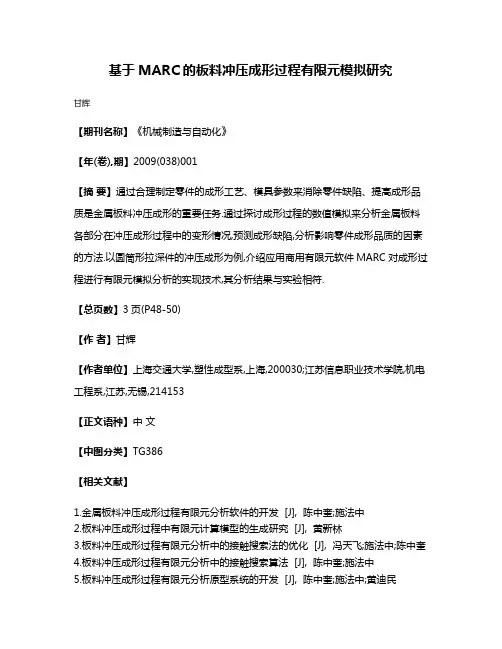
基于MARC的板料冲压成形过程有限元模拟研究
甘辉
【期刊名称】《机械制造与自动化》
【年(卷),期】2009(038)001
【摘要】通过合理制定零件的成形工艺、模具参数来消除零件缺陷、提高成形品质是金属板料冲压成形的重要任务.通过探讨成形过程的数值模拟来分析金属板料各部分在冲压成形过程中的变形情况,预测成形缺陷,分析影响零件成形品质的因素的方法.以圆筒形拉深件的冲压成形为例,介绍应用商用有限元软件MARC对成形过程进行有限元模拟分析的实现技术,其分析结果与实验相符.
【总页数】3页(P48-50)
【作者】甘辉
【作者单位】上海交通大学,塑性成型系,上海,200030;江苏信息职业技术学院,机电工程系,江苏,无锡,214153
【正文语种】中文
【中图分类】TG386
【相关文献】
1.金属板料冲压成形过程有限元分析软件的开发 [J], 陈中奎;施法中
2.板料冲压成形过程中有限元计算模型的生成研究 [J], 黄新林
3.板料冲压成形过程有限元分析中的接触搜索法的优化 [J], 冯天飞;施法中;陈中奎
4.板料冲压成形过程有限元分析中的接触搜索算法 [J], 陈中奎;施法中
5.板料冲压成形过程有限元分析原型系统的开发 [J], 陈中奎;施法中;黄迪民
因版权原因,仅展示原文概要,查看原文内容请购买。
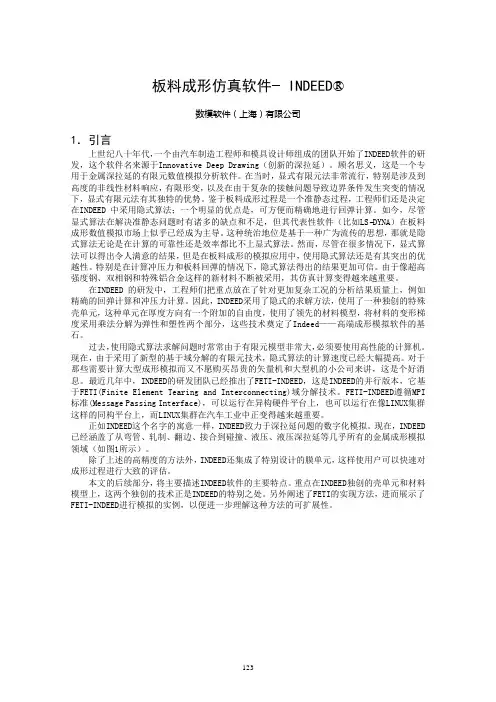
板料成形仿真软件− INDEED®数模软件(上海)有限公司1.引言上世纪八十年代,一个由汽车制造工程师和模具设计师组成的团队开始了INDEED软件的研发,这个软件名来源于Innovative Deep Drawing(创新的深拉延)。
顾名思义,这是一个专用于金属深拉延的有限元数值模拟分析软件。
在当时,显式有限元法非常流行,特别是涉及到高度的非线性材料响应,有限形变,以及在由于复杂的接触问题导致边界条件发生突变的情况下,显式有限元法有其独特的优势。
鉴于板料成形过程是一个准静态过程,工程师们还是决定在INDEED 中采用隐式算法;一个明显的优点是,可方便而精确地进行回弹计算。
如今,尽管显式算法在解决准静态问题时有诸多的缺点和不足,但其代表性软件(比如LS−DYNA)在板料成形数值模拟市场上似乎已经成为主导。
这种统治地位是基于一种广为流传的思想,那就是隐式算法无论是在计算的可靠性还是效率都比不上显式算法。
然而,尽管在很多情况下,显式算法可以得出令人满意的结果,但是在板料成形的模拟应用中,使用隐式算法还是有其突出的优越性。
特别是在计算冲压力和板料回弹的情况下,隐式算法得出的结果更加可信。
由于像超高强度钢、双相钢和特殊铝合金这样的新材料不断被采用,其仿真计算变得越来越重要。
在INDEED 的研发中,工程师们把重点放在了针对更加复杂工况的分析结果质量上,例如精确的回弹计算和冲压力计算。
因此,INDEED采用了隐式的求解方法,使用了一种独创的特殊壳单元,这种单元在厚度方向有一个附加的自由度,使用了领先的材料模型,将材料的变形梯度采用乘法分解为弹性和塑性两个部分,这些技术奠定了Indeed——高端成形模拟软件的基石。
过去,使用隐式算法求解问题时常常由于有限元模型非常大,必须要使用高性能的计算机。
现在,由于采用了新型的基于域分解的有限元技术,隐式算法的计算速度已经大幅提高。
对于那些需要计算大型成形模拟而又不愿购买昂贵的矢量机和大型机的小公司来讲,这是个好消息。
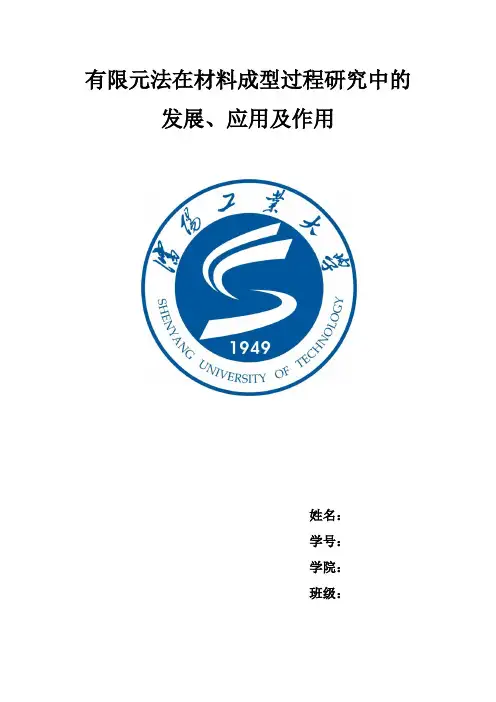
有限元法在材料成型过程研究中的发展、应用及作用姓名:学号:学院:班级:有限元法在材料成型过程研究中的发展、应用及作用材料加工是先进制造技术中重要的组成,它的应用涉及航空航天、汽车、石化、军事等事关国民经济的重要产业。
材料加工工艺过程中,除了运动和外力作用等因素,还涉及温度场、流场、应力应变场及内部组织的变化; 生产环境恶劣,控制因素多样。
因此,充分了解材料加工计算机模拟的重要性及其发展趋势,对于推动我国制造业的科技进步,缩短产品的开发和加工周期,快速响应市场,提高竞争能力,真正体现高速、高效、高质的制造优势,具有重要的意义。
计算机模拟是制造业发展的产物。
以有限元方法为基础的计算机模拟技术是20 世纪技术发展的巨大成果,在工程物理科学的各个分支领域都起着十分重要的作用。
新材料、新工艺、新产品、高要求、高精度、低成本的现代制造模式要求深入了解和掌握材料成形机理、过程变化,在计算机上实现过程显现,开拓科学的工艺和设计方法,实现最优设计与制造。
因此,计算机数值模拟技术以及以此为基础的优化设计方法研究成为当今和今后国内研究的热点。
我们知道在工程中使用的金属材料大多数为多晶材料,材料的微观组织形态直接影响零件的机械性能和物理性能,所以选择合理的加工工艺参数十分重要。
材料加工过程微观组织的计算机模拟由于具有描述分子级尺寸水平的能力,这将对控制材料晶粒大小及分布,进一步了解位错的产生和运动、晶界结构、防止内部空洞和微裂纹的萌生和扩展等问题提供了新的方法[1-2] ,将大大推动材料微观结构研究的进展,并对确定优化材料加工的工步数和顺序、热处理方案十分有益。
此外,在金属成形过程中,适用的优化准则对材料最终的力学性能和微观组织性能具有重要的影响,通过优化坯料形状或预成形模具形状、模具速度使最终锻件具有良好的尺寸精度、少无飞边和所期望的微观组织。
为此,一方面要要研究合适的优化设计变量的选择,包括影响终锻件力学组织性能的状态变量和过程变量,即形状设计变量和速度设计变量。
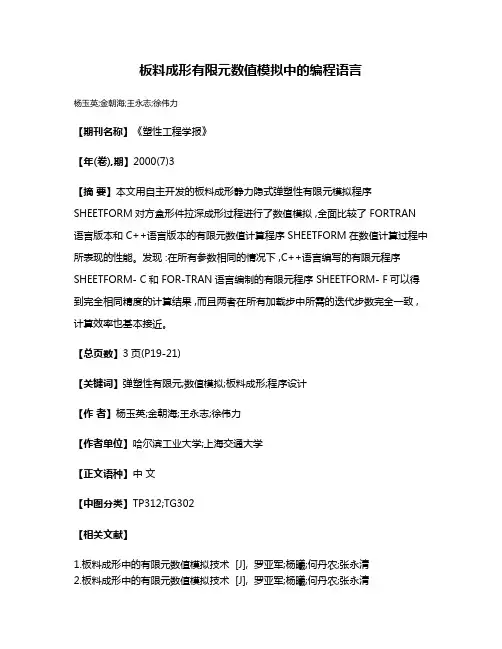
板料成形有限元数值模拟中的编程语言
杨玉英;金朝海;王永志;徐伟力
【期刊名称】《塑性工程学报》
【年(卷),期】2000(7)3
【摘要】本文用自主开发的板料成形静力隐式弹塑性有限元模拟程序SHEETFORM对方盒形件拉深成形过程进行了数值模拟 ,全面比较了 FORTRAN 语言版本和 C++语言版本的有限元数值计算程序 SHEETFORM在数值计算过程中所表现的性能。
发现 :在所有参数相同的情况下 ,C++语言编写的有限元程序SHEETFORM- C和 FOR-TRAN语言编制的有限元程序 SHEETFORM- F可以得到完全相同精度的计算结果 ,而且两者在所有加载步中所需的迭代步数完全一致 ,计算效率也基本接近。
【总页数】3页(P19-21)
【关键词】弹塑性有限元;数值模拟;板料成形;程序设计
【作者】杨玉英;金朝海;王永志;徐伟力
【作者单位】哈尔滨工业大学;上海交通大学
【正文语种】中文
【中图分类】TP312;TG302
【相关文献】
1.板料成形中的有限元数值模拟技术 [J], 罗亚军;杨曦;何丹农;张永清
2.板料成形中的有限元数值模拟技术 [J], 罗亚军;杨曦;何丹农;张永清
3.板料成形数值模拟有限元求解算法 [J], 陆璐; 王辅忠; 王照旭
4.有限元模型转换及其在金属板料成形数值模拟中的应用 [J], 邱智学;黄菊花;杨雪春;杨国泰;刘志云;谢世坤
5.AutoCAD在板料拉深成形有限元数值模拟中的应用 [J], 杜拴柱;贺涞庆
因版权原因,仅展示原文概要,查看原文内容请购买。
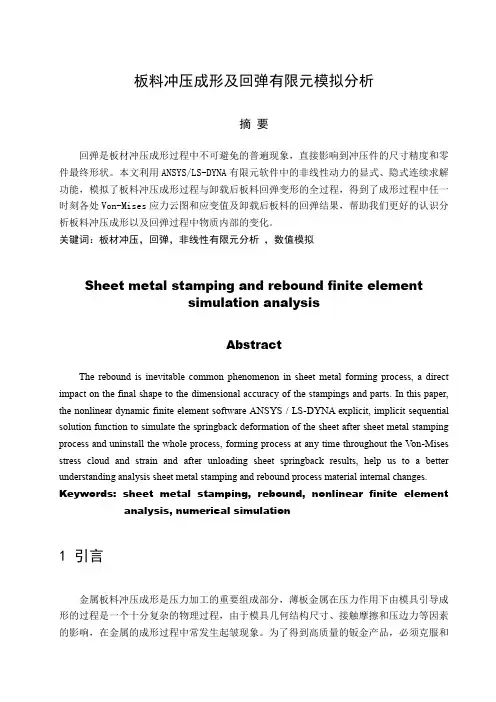
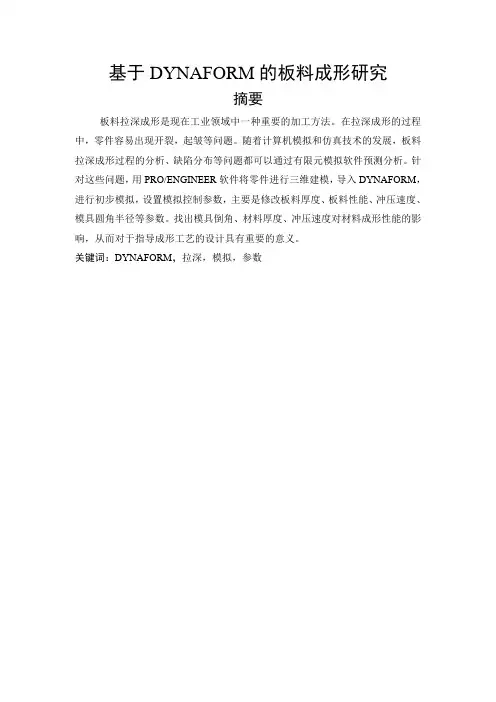
基于DYNAFORM的板料成形研究摘要板料拉深成形是现在工业领域中一种重要的加工方法。
在拉深成形的过程中,零件容易出现开裂,起皱等问题。
随着计算机模拟和仿真技术的发展,板料拉深成形过程的分析、缺陷分布等问题都可以通过有限元模拟软件预测分析。
针对这些问题,用PRO/ENGINEER软件将零件进行三维建模,导入DYNAFORM,进行初步模拟,设置模拟控制参数,主要是修改板料厚度、板料性能、冲压速度、模具圆角半径等参数。
找出模具倒角、材料厚度、冲压速度对材料成形性能的影响,从而对于指导成形工艺的设计具有重要的意义。
关键词:DYNAFORM,拉深,模拟,参数Based on the dynaform plate formingresearchAbstract:Deep drawing of sheet metal industry is now an important processing method. In the drawing forming process, the parts prone to cracking, wrinkling and other problems.Along with the computer simulation and the simulation technology development, the process of sheet forming analysis, defects distribution problems can be simulated by FEM software prediction analysis. To solve these problems, PRO / ENGINEER software part three-dimensional modeling, import on DYNAFORM, a preliminary simulation, set the parameters of analog control, primarily to modify the sheet thickness, sheet performance, pressing speed, die fillet radius and other parameters.Identify mold chamfer, material thickness, speed of pressing forming properties of the material, which for the guidance of the design of the forming process of great significance.Key words: DYNAFORM, drawing, simulation, parameter毕业设计(论文)原创性声明和使用授权说明原创性声明本人郑重承诺:所呈交的毕业设计(论文),是我个人在指导教师的指导下进行的研究工作及取得的成果。
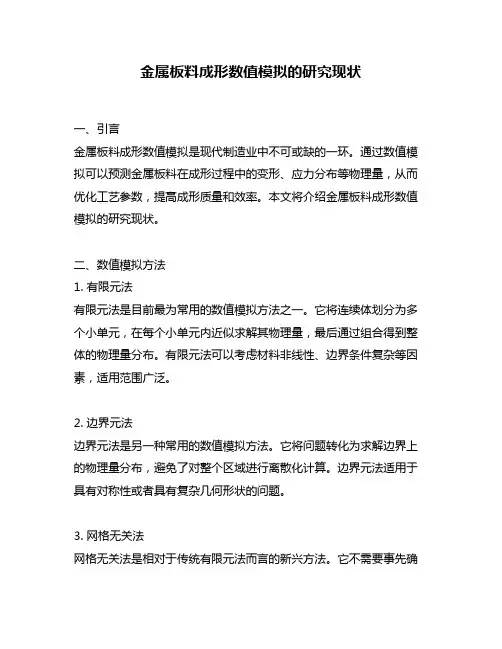
金属板料成形数值模拟的研究现状一、引言金属板料成形数值模拟是现代制造业中不可或缺的一环。
通过数值模拟可以预测金属板料在成形过程中的变形、应力分布等物理量,从而优化工艺参数,提高成形质量和效率。
本文将介绍金属板料成形数值模拟的研究现状。
二、数值模拟方法1. 有限元法有限元法是目前最为常用的数值模拟方法之一。
它将连续体划分为多个小单元,在每个小单元内近似求解其物理量,最后通过组合得到整体的物理量分布。
有限元法可以考虑材料非线性、边界条件复杂等因素,适用范围广泛。
2. 边界元法边界元法是另一种常用的数值模拟方法。
它将问题转化为求解边界上的物理量分布,避免了对整个区域进行离散化计算。
边界元法适用于具有对称性或者具有复杂几何形状的问题。
3. 网格无关法网格无关法是相对于传统有限元法而言的新兴方法。
它不需要事先确定网格大小和结构,可以自动适应物理量分布的变化。
网格无关法适用于具有较大变形或者复杂几何形状的问题。
三、数值模拟在金属板料成形中的应用1. 成形过程分析数值模拟可以对金属板料成形过程进行分析,预测变形、应力分布等物理量。
通过优化工艺参数,可以避免一些不必要的缺陷和失效。
2. 模具设计数值模拟可以为模具设计提供依据。
通过对成形过程中应力和变形的预测,可以确定合适的模具结构和尺寸,从而达到更好的成形效果。
3. 材料选择数值模拟还可以为材料选择提供参考。
通过预测不同材料在成形过程中的性能表现,可以选择最为适合的材料,提高生产效率和质量。
四、数值模拟存在的问题及发展趋势1. 计算精度问题目前数值模拟存在计算精度不高、计算时间长等问题。
需要进一步发展更加高效精确的数值模拟方法。
2. 跨尺度建模问题金属板料成形涉及到多个尺度,如宏观尺度、晶体尺度等。
如何将不同尺度的模型相结合,进行跨尺度建模是一个重要的研究方向。
3. 多物理场耦合问题金属板料成形涉及到多种物理场,如力学、热学、电磁学等。
如何将这些物理场相互耦合起来进行计算,是数值模拟发展的重要方向之一。

材料成型及控制工程外文翻译文献(文档含英文原文和中文翻译)在模拟人体体液中磷酸钙涂层激光消融L. Cle`ries*, J.M. FernaHndez-Pradas, J.L. Morenza德国巴塞罗那大学,西班牙1999年七月二十八日-2000年2月文摘:三种类型的磷酸钙涂层基质,在钛合金激光烧蚀技术规定提存,沉浸在一个模拟的身体# uid为了确定条件下他们的行为类似于人的血浆。
羟基磷灰石涂层也也非晶态磷酸钙涂层和a-tricalcium磷酸盐做溶解阶段b-tricalcium磷酸盐的涂料有细微的一个阶段稍微瓦解。
一个apatitic阶段降水量偏爱在羟基磷灰石涂层的涂料磷酸b-tricalcium上有细微的一个阶段。
在钛合金基体上也有降水参考,但在大感应时代。
然而,在非晶态磷酸钙涂层不沉淀形成。
科学出版社有限公司(2000保留所有权利。
关键词:磷酸钙,脉冲激光沉积,SBF1 介绍激光消融技术用于沉积磷酸钙涂层金属基体上,将用作植体骨重建。
用这个技术,磷酸钙涂层量身定做阶段和结构也成功地研制生产了[1,2]和溶解特性鉴定海洋条件]。
然而,真正的身体条件# uid饱和对羟基磷灰石的阶段,这是钙离子的浓度高于均衡的这个阶段。
因而,这就很有趣也测试条件磷酸钙涂料接近体内的情况,以了解其完整性,在这些条件及其催化反应性质}表面沉淀过程。
因此,非晶态磷酸钙涂层(ACP),羟基磷灰石(HA)涂层,涂层中的一个阶段b-tricalcium磷酸盐较小(ba-TCP)积下激光烧蚀是沉浸在饱和溶液为迪!时间、不同的结构性演变进行了测定。
饱和溶液的使用的是身体uid(SBF模拟#),解决了其离子浓度、酸碱度几乎等于那些人类血浆[5]。
该解决方案也是一个利用在仿生(沉淀)工艺生产磷灰石层在溶胶凝胶活性钛基体。
2 实验模拟身体化学溶解试剂级严格依照以下的顺序,除氢钠,NaHCO3:)3,K2HPO4 H2O,MgCl2)6 H2O,氯化钙和Na2SO4)2 H2O,在去离子水。
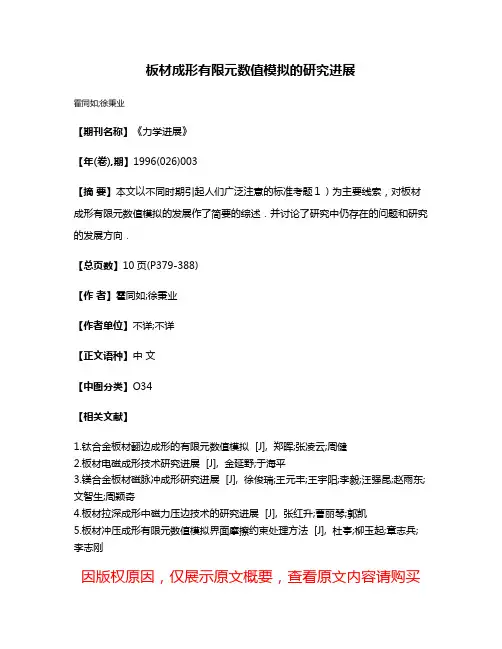
板材成形有限元数值模拟的研究进展
霍同如;徐秉业
【期刊名称】《力学进展》
【年(卷),期】1996(026)003
【摘要】本文以不同时期引起人们广泛注意的标准考题1)为主要线索,对板材成形有限元数值模拟的发展作了简要的综述.并讨论了研究中仍存在的问题和研究的发展方向.
【总页数】10页(P379-388)
【作者】霍同如;徐秉业
【作者单位】不详;不详
【正文语种】中文
【中图分类】O34
【相关文献】
1.钛合金板材翻边成形的有限元数值模拟 [J], 郑晖;张凌云;周健
2.板材电磁成形技术研究进展 [J], 金延野;于海平
3.镁合金板材磁脉冲成形研究进展 [J], 徐俊瑞;王元丰;王宇阳;李毅;汪强昆;赵雨东;文智生;周颖奇
4.板材拉深成形中磁力压边技术的研究进展 [J], 张红升;曹丽琴;郭凯
5.板材冲压成形有限元数值模拟界面摩擦约束处理方法 [J], 杜亭;柳玉起;章志兵;李志刚
因版权原因,仅展示原文概要,查看原文内容请购买。
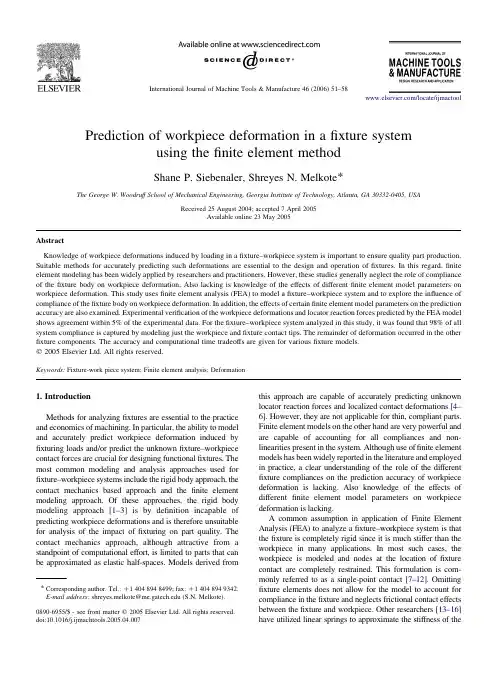
Prediction of workpiece deformation in afixture systemusing thefinite element methodShane P.Siebenaler,Shreyes N.Melkote*The George W.Woodruff School of Mechanical Engineering,Georgia Institute of Technology,Atlanta,GA30332-0405,USAReceived25August2004;accepted7April2005Available online23May2005AbstractKnowledge of workpiece deformations induced by loading in afixture–workpiece system is important to ensure quality part production. Suitable methods for accurately predicting such deformations are essential to the design and operation offixtures.In this regard,finite element modeling has been widely applied by researchers and practitioners.However,these studies generally neglect the role of compliance of thefixture body on workpiece deformation.Also lacking is knowledge of the effects of differentfinite element model parameters on workpiece deformation.This study usesfinite element analysis(FEA)to model afixture–workpiece system and to explore the influence of compliance of thefixture body on workpiece deformation.In addition,the effects of certainfinite element model parameters on the prediction accuracy are also examined.Experimental verification of the workpiece deformations and locator reaction forces predicted by the FEA model shows agreement within5%of the experimental data.For thefixture–workpiece system analyzed in this study,it was found that98%of all system compliance is captured by modeling just the workpiece andfixture contact tips.The remainder of deformation occurred in the other fixture components.The accuracy and computational time tradeoffs are given for variousfixture models.q2005Elsevier Ltd.All rights reserved.Keywords:Fixture-work piece system;Finite element analysis;Deformation1.IntroductionMethods for analyzingfixtures are essential to the practice and economics of machining.In particular,the ability to model and accurately predict workpiece deformation induced by fixturing loads and/or predict the unknownfixture–workpiece contact forces are crucial for designing functionalfixtures.The most common modeling and analysis approaches used for fixture–workpiece systems include the rigid body approach,the contact mechanics based approach and thefinite element modeling approach.Of these approaches,the rigid body modeling approach[1–3]is by definition incapable of predicting workpiece deformations and is therefore unsuitable for analysis of the impact offixturing on part quality.The contact mechanics approach,although attractive from a standpoint of computational effort,is limited to parts that can be approximated as elastic half-spaces.Models derived from this approach are capable of accurately predicting unknown locator reaction forces and localized contact deformations[4–6].However,they are not applicable for thin,compliant parts. Finite element models on the other hand are very powerful and are capable of accounting for all compliances and non-linearities present in the system.Although use offinite element models has been widely reported in the literature and employed in practice,a clear understanding of the role of the different fixture compliances on the prediction accuracy of workpiece deformation is lacking.Also knowledge of the effects of differentfinite element model parameters on workpiece deformation is lacking.A common assumption in application of Finite Element Analysis(FEA)to analyze afixture–workpiece system is that thefixture is completely rigid since it is much stiffer than the workpiece in many applications.In most such cases,the workpiece is modeled and nodes at the location offixture contact are completely restrained.This formulation is com-monly referred to as a single-point contact[7–12].Omitting fixture elements does not allow for the model to account for compliance in thefixture and neglects frictional contact effects between thefixture and workpiece.Other researchers[13–16] have utilized linear springs to approximate the stiffness oftheInternational Journal of Machine Tools&Manufacture46(2006)51–58/locate/ijmactool0890-6955/$-see front matter q2005Elsevier Ltd.All rights reserved.doi:10.1016/j.ijmachtools.2005.04.007*Corresponding author.Tel.:C14048948499;fax:C14048949342.E-mail address:*************************.edu(S.N.Melkote).fixture components.However,such an approach requires the stiffness to be measured or approximated,adding time and introducing potential error into the analysis.Recent work [17–19]has explored the use of surface-to-surface contact elements.Such an approach allows frictional effects to be modeled.This methodology was used for the work reported in this paper.Liao et al.[17]used FEA with contact elements to model a multiple-contact fixture system.They,however,did not investigate the effects of friction and meshing parameters on the results.Satyanarayana’s [18,19]work was limited to a single fixture–workpiece contact.More importantly,these studies did not analyze the contribution of fixture body compliance to the overall deformation.This paper investigates the effects of various finite element modeling parameters,such as friction and mesh density,on workpiece deformation.In addition to modeling the workpiece and fixture tips,as is common,the effect of compliance of other fixture components such as support blocks,base plate,etc.on workpiece deformation is also examined.The FEA predictions of workpiece deformation and locator reactions are experimentally verified.2.Fixture–workpiece systemThe fixture–workpiece system used in this study consisted of a hollow block of rectangular section anduniform wall thickness restrained in a 3-2-1fixture layout as shown in Fig.1.The aluminum 6061-T6(E Z 70GPa,n Z 0.334)workpiece measured 153mm !127mm !76mm and had a fixed wall thickness (t in Fig.1)ranging from 6to 10mm.Two clamps were used to press the workpiece against six locators:three on the primary plane,two on the secondary plane,and one on the tertiary plane.Spherical and planar hardened AISI 1144steel (E Z 206GPa,n Z 0.296)fixture tips with black oxide finish were used to locate and clamp the workpiece.The global coordinates of each tip are given in Table 1.3.Model developmentFinite element models were constructed using ANSYS w Version 5.7.Solid models were assembled of the prismatic block and fixture tips.All components in the system were modeled as isotropic elastic bodies.The fixture tips,shown in Fig.2,were modeled as cylinders with either planar (clamp and locator circular contact areas 60and 127mm 2,respectively)or spherical (35mm radius of curvature)end caps.The axial lengths of the planar and spherical tips were 6.4and 10.2mm,respectively.The 10-node tetrahedral element Solid92was used to mesh all solid bodies.Contact between the workpiece and fixture was simu-lated using the quadratic surface-to-surface contact elements Targe170and Conta174.A constant static coefficient of friction was used to establish contact proper-ties at the interfaces.To simulate the locators beingrigidlyZyout of 3-2-1fixture.Table 1Coordinates of locator tipsPlanar Spherical X (mm)Y (mm)Z (mm)X (mm)Y (mm)Z (mm)L130.80.041.927.00.038.1L2132.40.041.9128.60.038.1L30.080.041.90.076.238.1L410.524.80.0 6.721.00.0L510.5112.00.0 6.7108.20.0L6154.066.60.0150.262.70.0C179.1127.041.375.3127.037.5C2153.067.341.3153.063.537.5S.P.Siebenaler,S.N.Melkote /International Journal of Machine Tools &Manufacture 46(2006)51–5852fixed in place,the surface of each locator tip opposite to the contact was restrained in all three translational degrees of freedom.A uniformly distributed pressure was applied over the surface of both clamps in opposite contact to simulate the desired clamping force.The deformation of the workpiece,analyzed in the subsequent sections,was found at two points on the workpiece.The positive directions of these two points,d C1and d C2,are shown in Fig.3.The selection of points was based upon locations on the workpiece that underwent the most deformation due to clamping.3.1.Sensitivity to friction coefficientLaboratory tests conducted by Satyanarayana [18]on the same fixture–workpiece system found an average static coefficient of friction (m )of 0.18between the workpiece and fixture tips.The average was in a range of experimental values from 0.15to 0.25.To test the effect of friction of workpiece deformation prediction,FEA models were constructed for workpiece wall thicknesses of 6–10mm restrained in the fixture previously described.A spectrum of m from 0.15to 0.30was tested in combination with the various wall thicknesses.A summary of the deformation results is given in Table 2.An average difference of 3.1%in deformation prediction was found for a change in m of 0.05.These results show that the effect of small variations in the friction coefficient on the workpiece deformation is quite small.3.2.Treatment of primary plane locatorsA series of models were constructed to determine the influence of the primary plane locators.For a properly designed 3-2-1layout in which workpiece rotation is prevented,the only normal load taken by the three primary plane locators is the weight of the workpiece.The frictional force produced by such a small load is often dwarfed by the much larger clamping loads.An analysis was performed to determine if the frictional effects at these locators must be accounted for in a modeling approach.Two sets of boundary conditions were applied to blocks with wall thicknesses of 7,8,and 9mm.The first set,Case A,included all three primary plane locators subjected to the previously described surface-to-surface contact bound-ary conditions.A value of 0.18was specified for m .The second configuration,Case B,removed all three of the primary plane locators and simply restrained the bottom surface of the workpiece from translating in the z -direction.A summary of the results is given in Table 3.The FEA showed that the predicted deformations differed between the two boundary condition sets by an average of only 1.31%.This small impact of the bottom locators allows the FEA models to be constructed without the primary plane locators,thus saving considerable computational time.This (Case B)boundary condition set used only 77and 69%of the complete model computational time for the planar and spherical tips,respectively.The omission of the three primary plane locators coupled with restraining the bottom surface of the workpiece was the configuration used for subsequent models.It should be pointed out that this approximation may not be valid when machining loads are also taken intoaccount.Fig.2.Fixture tip geometry.Table 2Effect of variation in friction coefficient w (mm)m d C1(m m)d C2(m m)100.1515.018.00.2015.016.50.2515.015.60.3015.114.790.1520.022.60.2020.021.10.2519.918.90.3020.118.980.1528.030.10.2027.828.60.2527.827.20.3028.225.770.1541.042.20.2040.640.40.2540.738.50.3041.336.360.1564.965.90.2064.463.30.2564.960.2Fig.3.Workpiece deformation points.S.P.Siebenaler,S.N.Melkote /International Journal of Machine Tools &Manufacture 46(2006)51–58534.Effect of mesh densityWhile some published literature uses FEA to analyze workpiece deformation,a rigorous study of the influence of mesh density on the modeling of fixture–workpiece compliance is lacking.A key factor in determining an appropriate FEA model for this investigation is to select the ideal mesh density.A coarse mesh might yield inaccurate results.However,too fine a mesh might be unnecessary as well as computationally expensive.For this study,the SMRT smart-meshing function of ANSYS w was utilized to construct the solid mesh.Discrete values ranging from 1(most dense mesh)to 10(least dense mesh)were assigned to the various solid parts.A wide spectrum of combinations of fixture and workpiece mesh sizes was used to determine the optimal mesh size.To test the accuracy of the results,the deformation of the workpiece,d C1and d C2,at the location of the two clamps was computed.Experimental results were used as a benchmark for assessing the validity of the simulated results.A test fixture with dimensions identical to the models was constructed.The workpiece for this study had a uniform wall thickness of 7mm.The fixture elements were fastened to a 15mm thick steel base plate.The threaded fixture tips on the primary plane were screwed directly into the base plate.The other locators were screwed into steel support blocks that were in turn each fastened to the base plate via four bolts and two press-fit dowel pins.A picture of the fixture is given in Fig.4.The two clamps,which were similarly fastened to the base plate via steel support blocks,were actuated by a hydraulic hand pump.The order of clamp actuation can influence workpiece deflection as shown by otherresearchers [20,21]and in previous work by the authors [22].However,in the current study,the two clamps were actuated simultaneously by a single hydraulic pump.The difference in actuation times for the two clamps was deemed to be negligible.The deformation at each point was measured using an eddy current proximity probe.The change in magnetic flux of a target patch detected by the sensor was converted to a displacement value by the data acquisition system.Average deformation results over five trials for each tip and load pair are given in Table 4.The standard deviation for the measurements was 0.43m m.Figs.5and 6show the percentage error between the experimentally measured values and the FEA results for the planar and spherical tip cases,respectively.Plots of the 250N load case at Clamp 1for both spherical and planar tips are given for each wall thickness tested.A similar trend was found for the deformation at Clamp 2as well as for a load of 350N.As depicted in the plots,the workpiece mesh density has the dominant effect on model accuracy.A coarse mesh density can produce results with as much as 20%error.However,as can be observed in Fig.6,the influence of fixture tip mesh density on the accuracy of the results is much less.The workpiece and fixture SMRT density levels for the planar case,which provided the most accurate results,were five and two,respectively.No finite element meshes denser than this combination altered the predicted deformations.For the spherical tip case,a SMRT mesh density level of six for the workpiece and two for the fixture components wasTable 3Effect of primary plane locators w (mm)md C1(m m)d C2(m m)AB %Diff.A B %Diff.100.1515.014.6 2.7618.017.8 1.020.2015.014.6 2.9216.516.40.740.2515.014.5 3.0615.615.50.540.3015.114.6 3.2114.714.60.1690.1520.019.4 2.8922.622.50.810.2020.019.5 2.6321.120.9 1.160.2519.919.4 2.5820.119.9 1.120.3020.119.6 2.6318.918.80.8180.1528.027.4 2.2330.130.00.060.2027.827.3 1.8328.628.50.490.2527.827.2 2.0027.227.20.110.3028.227.6 1.9825.725.70.0770.1541.040.3 1.5842.242.20.110.2040.639.9 1.8040.440.60.610.2540.740.0 1.5238.538.80.690.3041.340.6 1.5736.336.70.9960.1564.964.30.9265.965.50.640.2064.463.7 1.1563.363.20.120.2564.964.30.9160.260.10.23Table 4Experimental datad C1(m m)d C2(m m)250N Planar 26.520.5Spherical 29.428.3350NPlanar 36.228.9Spherical41.338.5Fig.4.Experimental 3-2-1fixture.S.P.Siebenaler,S.N.Melkote /International Journal of Machine Tools &Manufacture 46(2006)51–5854chosen.Table 5summarizes these results.As the table shows,the finite element model provides solutions with less than 5%error for the designated mesh density levels.The selected mesh densities were used in all subsequent analyses.A summary of the element properties corresponding to the selected mesh density levels is presented in Table 6.5.Validation of selected mesh parametersThe general validity of the finite element mesh parameters obtained above for the fixture–workpiece system was established by applying the same mesh guidelines to a different load–wall thickness combination.An identical experimental set-up was used as in Section 4.The wallthickness of the block was 8mm and a 375N clamping load was utilized.Table 7presents the corresponding exper-imental and FEA results.As the table shows,there is less than 5%error between the FEA and experimental values,–20.00%–18.00%–16.00%–14.00%–12.00%–10.00%–8.00%–6.00%–4.00%–2.00%0.00%1234567SMRT Size (Fixture)% E r r o r i n d C 1Fig.5.Percentage error for various workpiece density levels (planar tips).12345678SMRT Size (Fixture)–30.00%–25.00%–20.00%–15.00%–10.00%–5.00%0.00%% E r r o r i n d C 1Fig.6.Percentage error for various workpiece density levels (spherical tips).Table 5Predicted vs.measured results for selected mesh density levels250N 350N d C1(m m)d C2(m m)d C1(m m)d C2(m m)Planar Measured 26.520.536.228.9FEA 25.320.335.428.5%Error K 4.55K 0.91K 2.19K 1.55Spherical Measured 29.428.341.338.5FEA 28.727.739.438.8%ErrorK 2.34K 2.17K 4.530.71S.P.Siebenaler,S.N.Melkote /International Journal of Machine Tools &Manufacture 46(2006)51–5855thus establishing the adequacy of the selected mesh parameters for the given fixture–workpiece system.6.Reaction force predictionAnother point of interest was the reaction forces between the locators and workpiece.Knowledge of reaction forces is important to ensure stability and equilibrium in the system.A series of experiments were run using the set-up shown in Fig.4to determine the reaction forces at Locators 1–3.Pressure-sensitive (Fuji Pre-scale)film was used at each of the three locator–workpiece contacts to produce a color intensity map.The individual images were mapped into a density array via a regression analysis to determine the contact pressure [23].The area of the imprint was found using a photo-editing program,leading to the determination of the reaction forces.The mesh parameters that were established in Section 5and a coefficient of friction of 0.18were used to predict reaction forces at the same locations.Table 8gives the results of the analysis.As can be seen from the table,FEA predictions are within 5%of the experimen-tal values thereby further validating the model.7.Effect of fixture body complianceThe models described in the previous sections only took into account the workpiece and the fixture tips.Most published analyses of fixtures assume that the fixture is rigid due to its considerably higher stiffness compared to that of the workpiece.Thus,these studies do not model the fixture itself and cannot account for any deformation effects of the fixture components.This paper,however,sought to investigate the contribution of fixture compliance to the overall predicted workpiece deformation by modeling various fixture elements.The components that were modeled in addition to the contact tips were the fixture support blocks,base plate,and clamp supports as shown in Fig.7.A series of models were constructed incorporating various combinations of these components.The support blocks and base plate were constructed to be solid prismatic blocks with dimensions matching those in the physical set-up.The support blocks had dimensions 63.5mm !50.8mm !73.8mm.The steel base plate had dimensions of 305mm !305mm !15mm.The planar and spherical tip fixture element dimensions were the same as those mentioned earlier in the paper.The fixture tips were modeled as fastened to the support blocks via the vglue command of ANSYS w .The support blocks were similarly affixed to the base plate and the bolt and dowel holes wereTable 6Mesh density parametersPlanarSpherical No.of WP elements 43807343WP element size (mm 3)65.2738.93No.of fixture elements 539423,408Fixture element size (mm 3)0.540.32Contact element size (mm 3)1.500.12Table 7Model validation resultsd C1(m m)d C2(m m)PlanarFEA26.321.4Measured 27.322.3%Error K 3.56K 4.14SphericalFEA32.826.4Measured 33.927.7%ErrorK 3.17K 4.71Table 8Comparison of measured and predicted locator reaction forcesMeasured (N)FEA (N)%Diff.F L1(N)Spherical 2508986K 2.9350126121K 3.9Planar2508481K 4.0350117113K 3.8F L2(N)Spherical 2509895K 2.9350138133K 3.6Planar25010299K 3.1350145139K 4.5F L3(N)Spherical 250170177 4.1350250248K 0.9Planar250177173K 2.1350244243K0.6Fig.7.Fixture components.S.P.Siebenaler,S.N.Melkote /International Journal of Machine Tools &Manufacture 46(2006)51–5856not modeled.Models that included the base plate used the vglue command to affix primary plane locating elements to the plate.For the models including the support blocks but not the base plate,the bottom surface of the blocks was constrained in all three translational degrees of freedom to simulate the blocks being fastened firmly to the base plate.The cylindrical clamp supports were modeled as solid cylinders that could only translate along the axis of the clamping force.The clamping pressure produced by the hydraulic pump was modeled as a uniformly distributed pressure across the area on the back surface of the clamp.FEA models of workpiece wall thicknesses of 7,8,and 9mm were used for the analysis.The loading conditions used are the same as those in Table 5.Workpiece deformation was also evaluated at the same locations as in the mesh density study.Results for the planar tip case are given in Table 9.The percent prediction error,averaged over both loading conditions and deformation locations,is given for FEA models including various fixture com-ponents.Also given in the table are computational times relative to the model containing only the fixture tips and workpiece.It is evident that modeling the additional individual fixture elements improved the accuracy of the FEA only slightly.The complete fixture model showed significant improvement in the simulated results,yielding results within 1%of the experimental values.However,the complete model required 653%of the computational time needed by the model consisting of just the workpiece and fixture tips.For the fixture with spherical tips,modeling of fixture components did not improve the accuracy of the results.The modeling of additional fixture components gave a more accurate representation of the fixture–workpiece interaction for the planar contact case.The deformation of the fixture itself,while small in comparison with that of the workpiece,influenced the overall system compliance.The FEA showed that 2.4%of the measured deformation is actually deformation in the fixture.The simulations showed that 22.7%of the fixture compliance occurs in the tips and the remaining 77.3%in the support system.Thus,the original model only containing the workpiece and fixture tips captured 98.1%of the overall system compliance.7.1.Significance of support block complianceAn analysis was performed to see how changes in the fixture compliance altered the overall system compliance.Complete fixture models of the initial configuration as well as cases for which the support blocks had different depths,D ,were run.The initial depth,D 0,is shown in Fig.8.Fig.9plots the percentage of system deformation occurring in the fixture itself for various normalized values of D .It would be expected that thinner blocks would deflect more than larger ones,shifting more deformation to the fixture.This assumption is confirmed in the plot.8.ConclusionsThis paper focused on the factors influencing the prediction of workpiece deformation when using the finite element method.Specifically,it analyzed the effects of different finite element modeling parameters such as contact friction,mesh density and fixture body compliance on the prediction of workpiece deformation.Predicted workpieceTable 9Effect of fixture compliance:planar tip caseAvg.error (%)Time (%)Fixture tips 2.30100Support blocks 1.76153Clamp supports 1.52305Blocks and supports 1.69346Complete fixture0.93653Fig.8.Support blockdepth.0.000.020.040.060.080.100.120.140.160.180.250.500.751D/D o d F /d T O TFig.9.Effect of support block compliance.S.P.Siebenaler,S.N.Melkote /International Journal of Machine Tools &Manufacture 46(2006)51–5857deformations and locator reaction forces were then experimentally verified.The simulation studies showed that models of the workpiece andfixture contacts based on surface-to-surface contact elements could predict workpiece deformations and reaction forces to within5%of the experimental values.The mesh density of the workpiece was found to be more vital to model accuracy than thefixture tip density.For thefixture–workpiece system analyzed in this paper,over98%of all system deformation could be captured by models containing only the workpiece andfixture tips.The remainder of system deformation is present in thefixture itself.The capturing of such compliance is possible by modeling the entirefixture body.However,a completefixture model requires over six-fold computational time. AcknowledgementsThis work was funded in part by the Caterpillar Technical Center and a matching grant from the Georgia Research Alliance.References[1]Y.C.Chou,V.Chandru,M.M.Barash,A mathematical approach toautomatic configuration of machiningfixtures:analysis and synthesis, ASME Journal of Engineering for Industry111(4)(1989)299–306.[2]E.C.DeMeter,Restraint analysis offixtures which rely on surfacecontact,ASME Journal of Engineering for Industry116(1993)207–215.[3]M.Y.Wang,D.M.Pelinescu,Contact force prediction and forceclosure analysis of afixtured workpiece with friction,ASME Journal of Manufacturing Science and Engineering125(2)(2003)325–332.[4]R.P.Sinha,J.M.Abel,A contact stress model for multi-fingeredgrasps of rough objects,Proceedings of the IEEE Conference on Robotics and Automation1990;1040–1045.[5]G.Xiuwen,J.Y.H.Fuh,A.Y.C.Nee,Modeling of frictional elasticfixture–workpiece system for improving location accuracy,IIE Transactions28(1996)821–827.[6]J.F.Hurtado,S.N.Melkote,A model for the prediction of reactionforces in a3-2-1machiningfixture,Transactions of NAMRI/SME26 (1998)335–340.[7]J.D.Lee,L.S.Haynes,Finite element analysis offlexiblefixturingsystem,ASME Journal of Engineering for Industry109(2)(1987) 124–139.[8]R.J.Menassa,W.R.DeVries,Optimization methods appliedto selecting support positions infixture design,Transactions of ASME,Journal of Engineering for Industry113(1991)412–418.[9]M.R.Rearick,S.Hu,S.Wu,Optimalfixture design for deformablesheet metalfixtures,Transactions of NAMRI/SME21(1993)407–412.[10]E.DeMeter,Fast support layout optimization,International Journal ofMachine Tools and Manufacture38(1998)1221–1239.[11]Y.J.Liao,S.J.Hu,D.A.Stephenson,Fixture layout optimizationconsidering workpiece–fixture contact interaction:simulation results, Transactions of NAMRI/SME26(1998)341–346.[12]S.L.Xie,S.J.Hu,W.Li,A.Sudjianto,Fixture configuration designusing a computer experiment,Proceedings of the ASME,Manufac-turing Science and Engineering11(2000)133–140.[13]J.Abou-Hanna,K.Okamura,Finite element approach to modelingparticulate bedfixtures,Journal of Manufacturing Systems11(1992) 1–12.[14]P.C.Pong,R.R.Barton,P.H.Cohen,Optimumfixture design,Proceedings of the Second Industrial Engineering Research Con-ference,1993pp.6–10.[15]P.Chandra,S.M.Athavale,S.G.Kapoor,R.E.DeVor,Finite elementbasedfixture analysis model for surface error prediction due to clamping and machining forces,Proceedings of ASME,Manufactur-ing Science and Technology,MED6.2(1997)245–252.[16]J.H.Yeh,F.W.Liou,Contact condition modeling for machiningfixture setup processes,International Journal of Machine tools and Manufacture39(1998)787–803.[17]Y.G.Liao,R.Khetan,R.Stevenson,An experimental investigationinto the deflection of afixture–workpiece system,Transactions of NAMRI/SME28(2000)413–418.[18]S.Satyanarayana,Fixture–workpiece contact modeling for a com-pliant workpiece,MS Thesis,Mechanical Engineering,Georgia Institute of Technology,2001.[19]S.Satyanarayana,S.N.Melkote,Finite element modeling offixture–workpiece contacts:single contact modeling and experimental verification,International Journal of Machine Tools and Manufacture 44(2004)903–913.[20]B.M.Bazrov,A.I.Sorokin,The effect of clamping sequence onworkpiece mounting accuracy,Soviet Engineering Research2(10) (1982)539–543.[21]P.Chandra,S.M.Athavale,R.E.DeVor,S.G.Kapoor,Effect ofpreloads on the surfaceflatness duringfixturing offlexible work-pieces,Proceedings of the First S.M.Wu Symposium,vol.2,1996pp.146–152.[22]A.Raghu,S.N.Melkote,Analysis of the effects offixture clampingsequence on part location errors,Journal of Machine Tools and Manufacture44(2004)373–382.[23]S.Siebenaler,Finite element approach to modeling deformation in afixture–workpiece system,MS Thesis,Mechanical Engineering, Georgia Institute of Technology,2003.S.P.Siebenaler,S.N.Melkote/International Journal of Machine Tools&Manufacture46(2006)51–58 58。
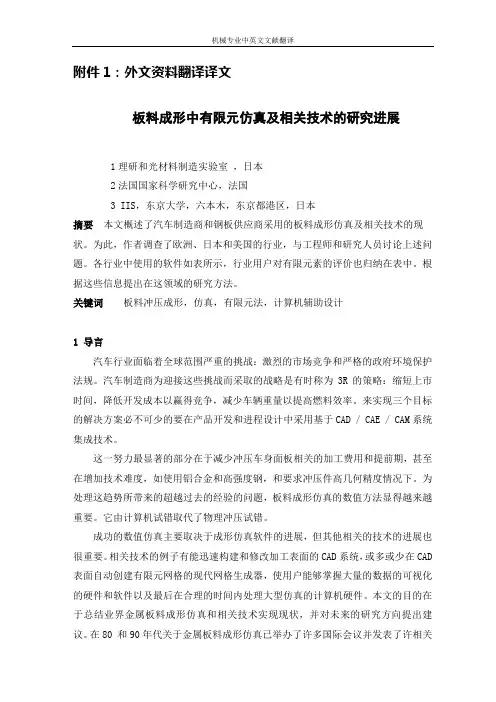
附件1:外文资料翻译译文板料成形中有限元仿真及相关技术的研究进展1理研和光材料制造实验室,日本2法国国家科学研究中心,法国3 IIS,东京大学,六本木,东京都港区,日本摘要本文概述了汽车制造商和钢板供应商采用的板料成形仿真及相关技术的现状。
为此,作者调查了欧洲、日本和美国的行业,与工程师和研究人员讨论上述问题。
各行业中使用的软件如表所示,行业用户对有限元素的评价也归纳在表中。
根据这些信息提出在这领域的研究方法。
关键词板料冲压成形,仿真,有限元法,计算机辅助设计1 导言汽车行业面临着全球范围严重的挑战:激烈的市场竞争和严格的政府环境保护法规。
汽车制造商为迎接这些挑战而采取的战略是有时称为3R的策略:缩短上市时间,降低开发成本以赢得竞争,减少车辆重量以提高燃料效率。
来实现三个目标的解决方案必不可少的要在产品开发和进程设计中采用基于CAD / CAE / CAM系统集成技术。
这一努力最显著的部分在于减少冲压车身面板相关的加工费用和提前期,甚至在增加技术难度,如使用铝合金和高强度钢,和要求冲压件高几何精度情况下。
为处理这趋势所带来的超越过去的经验的问题,板料成形仿真的数值方法显得越来越重要。
它由计算机试错取代了物理冲压试错。
成功的数值仿真主要取决于成形仿真软件的进展,但其他相关的技术的进展也很重要。
相关技术的例子有能迅速构建和修改加工表面的CAD系统,或多或少在CAD 表面自动创建有限元网格的现代网格生成器,使用户能够掌握大量的数据的可视化的硬件和软件以及最后在合理的时间内处理大型仿真的计算机硬件。
本文的目的在于总结业界金属板料成形仿真和相关技术实现现状,并对未来的研究方向提出建议。
在80 和90年代关于金属板料成形仿真已举办了许多国际会议并发表了许相关文章。
然而,通过这些信息还不足以解决上述问题。
由于这个原因,,作者决定访问调查欧洲、日本和美国的汽车行业和钢板供应商,与工作在模具冲压车间和企业冲压部门的工程师和研究人员来讨论这些具体课题。
在激光作用下核压力容器钢焊接接头的显微组织和力学性能摘要:设计间接热冲压工艺,利用有限元法对零件的几何尺寸和力学性能进行了预测.在间接热冲压过程的情况下,生产性能与适应车身部件,冷却路径造成扩散和扩散控制的相变。
通过人脸的相变引起的体积膨胀为面心立方(FCC)为体心立方(BCC)和体心四方(BCT)马氏体的形成导致相变诱导株的整体应力热冲压的车身部件的计算是很重要的。
计算的应力和应变状态正确,它是必要的模型的扩散和扩散控制的相变现象,考虑到间接热冲压过程的边界条件。
现有的材料模型进行分析和扩展以提高计算铁氧体、珍珠岩的数量和分布,其预测的准确性,整个退火过程中贝氏体和马氏体.工业用新方法在有限元程序LS-DYNA 971实现关键词:核钢稳压器压水反应堆反应堆压力容器结构完整性焊接韧性SA508钢通常用于民用核反应堆的关键部件,如反应堆压力容器。
核部件通常采用电弧焊接工艺,但与设计为未来的新建设项目超过60年的生活,新的焊接技术正在寻求.在这种探索性的研究,为第一时间,自体激光焊接6毫米厚的进行SA508 Cl。
3钢板使用16千瓦激光系统在4千瓦的功率运行。
这个显微组织和力学性能(包括显微硬度、抗拉强度、延伸率等夏比冲击韧性)的特点和结构进行了比较电弧焊接.基于移动体热的三维瞬态模型源模型也发展到模拟激光焊接热循环,以估计冷却速率的过程。
初步结果表明,激光焊接工艺可以无宏观缺陷的焊缝,激光焊接的强度和韧性在这项研究中的联合,得到的值,在焊接的母材条件。
反应堆压力容器的寿命和安全运行(RPV),这是核电站中最关键的部件之一.取决于高温压力容器材料的耐久性,高压力和放射性环境.具有较高强度,韧性和抗辐照脆化的材料的需要是上升的,由于增加的发电容量和核电厂的设计寿命[1 ],[ 2 ],[ 3 ],[ 4 ],[ 5 ],[7 ],[8 ]和[ 6 ].SA508钢已经用于许多RPV?的压水反应堆制造因为他们提供的结合强度,延展性好,断裂韧性,相对于机械性能的均匀性,和他们的经济[9 ]、[ 10 ]、[ 11 ]和[12 ].无人机是采用焊接厚环形锻件或SA508钢板在一起。
大型厚板变形成形的有限元仿真研究随着科学技术的不断发展,计算机仿真技术在加工制造领域中扮演着越来越重要的角色。
大型厚板变形成形的有限元仿真研究,是科技领域的重要研究方向之一。
在该领域中,有限元仿真技术是一种常用的方法。
本文将探讨大型厚板变形成形的有限元仿真研究的相关内容。
一、大型厚板的特点大型厚板是指钢板厚度大于20mm,长度和宽度都在2m以上的板材。
大型厚板制造技术是目前世界上最先进的钢板生产制造技术之一。
该技术制造出来的大型钢板具有以下几个特点:1. 承载能力强大型厚板的厚度和尺寸都比普通钢板大,因此其承载能力也比较强。
大型厚板经过特殊处理后,可以承受较大的压力和重量。
2. 抗冲击性好大型厚板使用特殊的钢材,经过特殊的处理,具有很好的抗冲击性。
即使在受到冲击时,也能保持稳定。
3. 安全性高大型厚板表面光滑、平整,不易发生裂纹和断裂。
因此,其使用安全性高,可以在工业生产和建筑领域中广泛应用。
二、大型厚板变形成形的有限元仿真研究在大型厚板制造中,变形成形过程是一个非常关键的环节,直接影响到钢板质量的优劣。
传统的制造方法采用机械冲压方式,生产效率低,精度难以控制。
因此,有限元仿真技术在大型厚板变形成形中的应用显得尤为重要。
1. 有限元仿真技术的优势有限元仿真技术是一种数值分析方法,通过将大型厚板模型划分为无限小的单元,以有限元方法为基础建立力学模型,计算分析模型的应力、应变、变形等力学行为,从而预测虚拟加工的加工结果。
有限元仿真技术主要具有以下优势:1)能够对大型复杂结构的零部件进行仿真分析。
2)能够模拟不同工况下的力学行为,同时对材料特性等重要参数进行分析,并优化加工过程。
3)能够快速得出预测结果,并为工艺优化提供参考。
2. 有限元分析模型有限元仿真技术的核心是建立模型,模型的设计直接影响到仿真结果的准确性。
在大型厚板变形成形的有限元仿真研究中,主要有以下几个方面的模型设计:1)模型生成首先,需要使用专业的 CAD 设计软件,通过 3D 化建立大型厚板的模型。
外文资料与中文翻译外文资料:Mold CAD/CAE/CAM technologyIntroductionMold CAD/CAE/CAM is transforms the traditional mold production method the essential technology, is a high tech, the high benefit systems engineering. It take the computer software form, provides one kind of effective auxiliary means as the enterprise, causes the engineers and technicians with the aid of in the computer to the product performance, the mold structure, the formed craft, the numerical control processing and the production management carries on the design and the optimization. Mold CAD/CAE/The CAM technology can remarkably reduce the mold design and the manufacture cycle, reduces the production cost and improves the product quality to become the mold mutual recognition.Is same with any newly emerging things, mold CAD/CAE/CAM experienced in the nearly 20 years from to has been simply complex, from experiment site to popular process. Since has entered this century, mold CAD/CAE/The CAM technological development speed quicker, the application scope is broader, in order to enable the general molds worker further to deepen to this technical understanding, better display mold CAD/CAE/The CAM function, this article applies in view of the mold in most widespread, most has the representative casting mold, the forging die and the level enters the mold CAD/CAE/The CAM development condition and the tendency make the concise introduction and the analysis.Casting mold CAD/CAE/CAM development surveyThe casting forming process simulation work begins in solves the casting the temperature field distribution. In 1962 Denmark's Fursund has carried on the solidification process heat transfer computation for the first time with the finite difference method to the two-dimensional shape casting, in 1965 US General Motors Henzel and so on has carried on the temperature field simulation to the steam turbine casting success, from this time on casting in mold cavity heat transfer process numerical analysis technology in world scope rapid development. From on century 70's to the 80's, US, England, France, Japan, Denmark and so on one after another has yielded the remarkable result in the casting coagulation simulator study and the application, and promotes one batch of commercialized simulations software one after another. After enters for the 90's, our country's institutions of higher learning, like Qinghua University and the Central China scientific and technical university has alsoobtained the achievement in this domain which focuses attention on.The pure heat transfer process simulation cannot accurately calculate the flaw which the casting in the temperature change and the forecast casting possibly produces, the sufficient mold process to in the casting initial temperature field distribution influence as well as the solidification process liquid metal flowing the influence which forms to the defect casting all is noticeable. The casting sufficient mold process simulation technology begins in the century for 80's, it take calculates the hydromechanics the theory and the method as the foundation, experiences ten years, starts from the two-dimensional simple shape, deepens and the expansion gradually, already succeeded has realized the three dimensional complex shape casting sufficient mold process simulation, and could flow with the heat transfer process coupling. At present overseas had one batch of commercialized the three dimensional casting process simulation softwares, like Japan's SOLIDIA, England's SOLSTAR, France's SIMULOR, Sweden's NOV ACAST, Germany's MAGMA and US'S AFSOLID, PROCAST and so on. The home also has Qinghua University star of, Central China scientific and technical university's the casting China casts CAE and so on. These casting mold CAE softwares have covered the cast steel, the cast iron, the cast-aluminium and the cast copper and so on each kind of casting, as is big as several hundred tons, slightly to several kilograms, regardless of is and shrinks the pine in the elimination shrink hole, in the optimized pouring rising head design, aspect and so on improvement dross entrapped slag has all played the remarkable role.Is following the CAE technology in the casting domain success application, the casting craft and the mold structure CAD research and the application in unceasingly is also thorough, overseas has promoted some application software one after another, like American casting association's AFS-SOFTWARE, may use in the cast steel and casts the iron stock the pouring rising head design, English FOSECO Corporation's FEEDERCALK software, may calculate the steel casting the pouring rising head size and a choice heat preservation rising head set of type. Our country Central China scientific and technical university and Qinghua University has also done many work in the casting craft and the mold structure CAD aspect, like Qinghua University develops the THFSCAD software, mainly and the vector and the casting craft CAD two parts is composed by the graph scanning. The preceding part to scans the input the graph to carry on disappears the blue decontamination and the vector, the latter part uses for to establish the parametrization graph, to calculate the casting theprocessing remainder, the plan craft card and so on. THFSCAD is develops in the two dimensional plot geometry foundation, used the AUTOCAD software for to develop the platform. Along with the CAD technology fast progress, the three dimensional CAD system can substitute for the two-dimensional CAD system in the casting realm of production but to become the mainstream design system gradually.Forging die CAD/CAE/CAM development surveySince on century 70's, domestic and foreign many academic organizations and company to forging die CAD/CAE/The CAM technology has conducted extensive research, in the forging technological process design, the forging die structural design and the metal flowed aspect and so on simulation has obtained the remarkable result.The axial symmetry forging approximately composes about forging total 30%, in addition axial symmetry forging geometry shape simple, is easy to describe and the definition, therefore development forging die CAD/ When CAM system the domestic and foreign majority organizations and the human all are obtain from the axial symmetry forging die. Axial symmetry forging die CAD/ CAM system main constituent including forging design, drop forging technological design, forging die structural design and NC programming. The forging design refers is designs the cold forging chart and the hot forging chart, divides the modular surface, the supplement machining remainder, the increase fillet including the choice and pulls out the mold ascent and so on. The drop forging technological design decided whether uses the preliminary shaping working procedure, how uses the preliminary shaping working procedure as well as how chooses the forging and stamping equipment the tonnage.Another kind of widespread application forging is the major axis class forging, its formed working procedure design and the mold structural design are far more complex than the axial symmetry forging die, therefore development major axis class forging die CAD/The CAM system difficulty bigger, the versatility is also low, at present in many general commercialized CAD/On the CAM software two time develops major axis class forging die CAD/The CAM system only is restricted in the specific product and the specific situation application.Another kind of widespread application forging is the major axis class forging, its formed working procedure design and the mold structural design are far more complex than the axial symmetry forging die, therefore development major axis class forging die CAD/The CAM system difficulty bigger, the versatility is also low, atpresent in many general commercialized CAD/On the CAM software two time develops major axis class forging die CAD/The CAM system only is restricted in the specific product and the specific situation application.In the CAE technology aspect, the finite element method always is the analysis and the research metal forging forming main numerical analysis method, for many years has yielded many gradual result. In 1973 Lee and Kobayashi derived just the plastic finite element Lagrange algorithm by the matrix analytic method, the success has analyzed the forging forming process. In 1974 Zienkiewicz proposed just the visco-plasticity finite element punished the function method, analyzed the rolling, has extruded and draws and so on the formed craft. In 1982 Mori and Osakada proposed just in the plastic finite element material might the compression method and uses in the rolling and the extrusion.On the century at the beginning of 80's, Oh and Altan had just conducted the thorough research with large-scale plastic finite element analysis software ALPID to each kind of plastic deformation question. After 90's, overseas some commercialized specialized finite element analysis softwares, like France's FORGE2, US'S DEFORM, ABAQUS, MSC/AutoForge and so on, all successfully has applied in the forging domain. These softwares not only may forecast the forging forms entire process, moreover may the quota produce with the distortion related each kind of physical quantity, like the displacement, the speed, the stress, the strain and the load and so on, for obtained the most superior mold design, the most reasonable craft plan and the least experimental molds time has provided the technical guarantee.The level enters mold CAD/CAE/CAM development surveyThe overseas level enters mold CAD/CAE/The CAM research begins in the century at the end of for 60's, the 70's then have the preliminary application, but only are restricted in the two-dimensional graph the simple blanking level to enter the mold, its main function like strip material row of type, concave mold arrangement, process design and NC programming and so on. The curving level enters mold CAD/The CAM system appears in the 80's, like Japanese Hitachi Corporation and the Fujitsu Corporation's curving level enters the mold system and so on. In order to can adapt the complex mold design, the Fujitsu system has used the method which the automatic design and designs alternately unifies, launches, the curving snapping back computation and a labor step of arrangement in this system except the semifinished materials for the automatic reduction outside, other need to design personnel'sparticipation.Applies the three dimensional geometry modelling technology the level to enter the mold system to begin in at the end of for the 80's, like American Auto-trol Corporation's Die-Design system, this system uses the three dimensional geometry model to describe the plate work components, and applies the three dimensional graph technology in the mold structural design, demonstrates the three dimensional graph software in mold design vital role.Enters for the 90's, international famous commercialized three dimensional CAD/CAM system, like US'S Pro/E, UG-II, CADD5, Solidworks, MDT and so on one after another obtain the application in the mold. American PTC Corporation based on Pro/The E system has developed plate work components modelling module Pro/Sheet Metal. UG Solution Corporation has developed similar module UG/ in the UG-II foundationSheet Metal. Above two systems all lack face the level enter the formed craft and the mold structural design special-purpose module, but this aspect work progress is very quick, some already won initial success.Like American Computer Design Corporation develops the level enters mold software Striker Systems is sales volume big commercialization CAD/The CAM system, including the plate work components modelling (SS-DESIGN), the semifinished materials launches (SS-UNFOLD), a semifinished materials row of type (SS-STRIP DESIGN), mold design (SS-DIE DESIGN) and numerical control processing (SS-WIRE, SS-PROFILE) and so on module. This system support plate work components characteristic modelling, although had certain automated designs the function, but its design process still by alternately operates primarily, only is suitable at present in the curving blanking level enters the mold the design.At the beginning of this century, American UGS Corporation and our country Central China scientific and technical university cooperation (presently is NX) in the software platform develops in UG-II enters mold CAD/ based on the three dimensional geometry model levelCAM software NX-PDW. This software including the project initialization, the craft pre- definition, the semifinished materials launches, a semifinished materials row of type, the waste material design, strip module and so on material row of type, pressure calculation and mold structural design. Has the trick recognition and the heavy construction, the entire three dimensional structure connection and so on the remarkable characteristic, has taken the commercialized product investment □field in 2003. Our country starts from on century 90's, theCentral China scientific and technical university, Shanghai Jiaotong University, the Xian Jiaotong University and the Beijing mechanical and electrical research institute and so on developed the level to enter mold CAD/ one after anotherCAM system research and development. Like the Central China scientific and technical university mold technology country key laboratory develops in the AutoCAD software platform enters mold CAD/ based on the characteristic levelCAM system HMJC, including the plate work components characteristic modelling, based on the characteristic ramming technological design, the mold structural design, the standard letter and the modular design constructs the storehouse tool and the line cuts automatically programs five modules. Shanghai Jiaotong University fine holds (Finetool) for Swiss Fyan to flush the company to develop the successful precise blanking level to enter mold CAD/CAM system. The Xian Jiaotong University develops the multi- locations curving level to enter the mold CAD system and so on.附录F:外文译文模具的CAD/CAE/CAM技术引言模具CAD/CAE/CAM是改造传统模具生产方式的关键技术,是一项高科技、高效益的系统工程。
板料冲压成形及回弹有限元模拟分析摘要回弹是板材冲压成形过程中不可避免的普遍现象,直接影响到冲压件的尺寸精度和零件最终形状。
本文利用ANSYS/LS-DYNA有限元软件中的非线性动力的显式、隐式连续求解功能,模拟了板料冲压成形过程与卸载后板料回弹变形的全过程,得到了成形过程中任一时刻各处Von-Mises应力云图和应变值及卸载后板料的回弹结果,帮助我们更好的认识分析板料冲压成形以及回弹过程中物质内部的变化。
关键词:板材冲压,回弹,非线性有限元分析,数值模拟Sheetmetalstamping and rebound finite elementsimulation analysisAbstractThe rebound is inevitablecommon phenomenon in sheet metal forming process, a directimpacton thefinal shape to the dimensional accuracy ofthestampings andparts. Inthispaper, the nonlineardynamic finite elementsoftware ANSYS / LS-DYNA explicit,implicitsequential solutionfunction to simulate thespringbackdeformation ofthe she et aftersheet metal stamping process and uninstall thewhole process, forming process at any time throughout the Von-Mises stress cloud andstrainandafter unloadingsheet springback results, helpus to a better understandinganalysis sheet metal stamping andrebound process material internal changes.Keywords: sheet metal stamping, rebound, nonlinear finite elementanalysis, numerical simulation1 引言金属板料冲压成形是压力加工的重要组成部分,薄板金属在压力作用下由模具引导成形的过程是一个十分复杂的物理过程,由于模具几何结构尺寸、接触摩擦和压边力等因素的影响,在金属的成形过程中常发生起皱现象。
英文资料Methods to study stamping formingThe objective of the stamping forming research is to realize and apply the principles to solve various engineering problems through study on the stamping forming procedure. Recently, the research on stamping has been carried out in wide range with various methods. The research can be summed up substantially into following types.The double line arrows in the picture denote the procedure of formal theoretical research. In such research, the actions of the equipment and die are decomposed into micro-ingredients of the force and applied on the microstructure of the metal according to the multi-crystal microstructure of the deformation metal, the deformation of the metal microstructure is then investigated and the deformation of the microstructure to macro-deformation of the sheet metal is summed up. This scientific method is perfect, but current development in mechanics and metallurgy cannot meet such demand, therefore this kind of formal theoretical research is still in burgeoning, and is not applicable in practice.Since the formal theoretical research method encounters formidable difficulty, a kind of simplified theoretical method appears in the research field of the stamping forming. The characteristic of this kind of research method is denoted by continuous line in the picture, which is the main trend of the recent research. This research assumes metal as the ideal homogeneous solid and simplifies the property parameters, the boundary conditions and the blank geometrical parameters of the metal, the stamping process and principle are analyzed and described by mathematical method. Naturally, the assumptions adopted in the analysis would induce some deviation between the real stamping process and its simulation. The result is certainly approximate and does not reflect the real stamping process completely. Especially in analyzing complex stamping forming, this theory is not so valid. In recent years, due to the development of the finite element method and computer technology, this kind of theoretical method has greatly progressed, it shows applicable prospect even in analyzing complex stamping forming. The application of this kind of theoretical method mainly focuses on some special stamping deformation investigation, and it is expected that more achievements can be obtained in the fundamental principle of stamping forming. On the other hand, due to the simplification and assumptions, experiments are indispensable to test the validity of this theory.The third method to study stamping forming is shown by dashed dotted line in the picture. The characteristic of this method is that ignoring the deformation process of the blank under the action of the load during stamping forming conditions (including the structure of the die, the geometrical parameters of the die working portion and the properties of the stamping equipment) with the final results of the stamping forming. It is a rational empirical method, and widely used in stamping technology filed in recent years. This method is intuitional, simple and easy to be adopted by engineers, but it cannot be used to reveal the real procedure of the stamping deformation, so it is not the radical method to investigate the principles of the stamping forming more thoroughly and its usage is strictly limited.The fourth method to study stamping forming is denoted by dashed line in thepicture. Based on the fundamental knowledge of the mechanics and metallurgy, the essential characteristics and principle of the stamping forming are investigated to solve the practical problems in stamping process. In comparison with other plastic processes, the characteristics of the stamping forming, the principles of the sheet metal deformation are unique. So this method has definitely aim and the analysis results can be used directly to solve different problems in stamping forming. The characteristics and effects of this research of this research of this research method are illustrated by following examples.(1)The sequence of the stamping process can be decided by the trend rule of the stamping deformation.(2)According to the rule of uniform velocity distribution in the outer flange of the deformation zone during multi-pass deep drawing for the box parts, the shape and dimension of the blank during process sequence can be calculated. Therefore the calculation the for deep box parts of the multi-pass deep drawing technology is based on scientific foundation to improve the technique level of stamping forming.(3)According to the research on the wrinkle during the sheet metal forming caused by non-uniform tensile and shearing force, a new research field is developed beyond the traditional compressive instability theory. The results obtained offer an effective measure to cope directly with wrinkle during stamping forming.(4)The theory of sorting stamping forming based on the characteristics of the stamping deformation and mechanics and mechanics is an easy approach to systematize of the stamping forming, and can be used to deepen the investigation on stamping forming limit, to point out a clear and definite direction for improve the stamping forming limit.Above examples indicate that this method is closely relevant to the real stamping forming process. It can be used to analyze and solve the stamping forming problems effectively. Although this method is in the junior stage, mainly focusing on the qualitative analysis for stamping forming now . With the constant progress of this method and combined with modern mechanics, the breakthrough of this method isexpected to further enhance stamping forming technology.Structural design of blanking diel. Principle and general procedure of die designingThe steps of die designing include collecting necessary data, determining the structure scheme based on sufficient analysis and investigation, drawing the working principle diagram, the final assembly diagram, and then drawing the part diagram of the die according to the final assembly diagram.The necessary data to be collected include: the parts drawing of the product, the productive batch of the product, the process chart, the process specification and the die design program. The manufacture datum of each operation, the types of the die structural (simple die, progressive die or compound die) , the capacity of the press, the quality of the blanking work piece and other necessary items should be record in the process chart and the process specification.The detailed structure and dimension of the die are determined according to the production batch and work piece demand, etc. For the small batch production, the structure of die should be simple, the manufacture period should be short, and the cost should be as low as possible. For the large batch, the perfect structure, high productivity and long working life should be pursued.Furthermore, the structure measures to adjust, utilize, maintain, transport and deposit the dies should be taken into account.2. Determination of the pressure center of dieThe acting point of the resultant force in blanking is called the pressure center of die. In order to guarantee the die to work smoothly, the pressure center of die should align with the axes of shank and the center line of the slide block of press, to prevent the deflection of die during working, which would result in non-uniform clearance and wearing. Usually, the pressure center of die is laid on its symmetrical center point. The determination of the pressure center of die is mainly for the complex, multi-punch punching and progressive dies.For the work piece with complex shape, it can be divided into straight-linesection (the pressure center of die is situated at the middle of the straight) and arc section, and then to calculate its pressure center.The method to find the resultant force of the parallel force system is usually adopted to obtain the pressure center of die. The procedure to obtain the pressure center of die for multi-punch blanking by analytic method is showns chematically in .(1) Draw the outline of the working portion of punch proportionally.(2) Select the co-ordinate X-Y. The selection of the co-ordinate should simplify the calculation.(3)calculate the perimeter of each graphic outline (or linear section)L1,L2,L3,L4,..., L n(representing the blanking force), and the distance of gravity center in each graphic outline to the coordinate axes x1, x2, x3, x4, ...,x n and y1,y2,y3,y4,...,y n.(4) According to the mechanic principle that "the moment of the resultant force to a certain axis is equal to the sum of the moment of each component to the same axis", the calculation equation of the distance from the die pressure center to the axes of X and Y can be obtained:x0=L1x1+L2x2+L3x3+⋯+L n x n(3-20)L1+L2+L3+⋯+L n(3-21) y0=L1y1+L2y2+L3y3+⋯+L n y nL1+L2+L3+⋯+L nThe determination of the pressure center of die can also be obtained graphically by the linear polygon method.3. Determination of the shut height of dieThe outline dimension of die should fit with the selected example,the lower die of the blanking should be able to install in the working table of the press,the dimension of the shank should be consistent with that of the hole in the slide block,the ejecting pin of the ejecting device in the lower die should be able to penetrate through the bolster hole of press. The shut height of die should be consistent with that of the press.The shut height of die refers to the distance H between the top surface of the upper bolster and bottom surface of the lower bolster when the die is in the lowest working position. The shut height of press refers to the distance between the lower surface of the slide block and the upper surface of the bolster installed in the working bable when the slide block is in the lower dead point. The height when the length of the connecting rod is adjusted to the shortest, is called the maximum shut height H max; the height when the length of the connecting rod is adjusted to the longest, is called the minimum shut height H min, as shown schematically in . The shut height of die is between the maximum and minimum shut height of press, usually:If the shut height of die is larger than the maximum height of press, the die cannot be used in this press; oppositely, if the shut height of die is less than the minimum height, the die can be used by adding a bolster.中文翻译冲压成形的研究方法冲压成形的研究工作,就是在正确而深入地了解冲压成形过程的基础上,认识冲压成形过程中的各种规律性的内容,并把它运用于解决冲压生产中出现的各种实际问题。
板料冲压成形的数学分析和有限元模拟王蕊;靳利【摘要】Stamping is the basic plastic processing method,which is mainly used for the processing of sheet metal and non-metallicmaterials.Stamping not only high efficiency,easy operation,and good quality,which is wide used in various national economy fields.The mathematical analysis and finite element simulation of sheet metal stamping proposed in this paper has a great significance to further promote stamping.%冲压成形是塑性加工的基本方法,它主要用来加工金属和非金属板料。
冲压加工由于具有生产效率高,操作方便,而且成形质量好的特点而在国民经济的各个领域具有非常广泛的应用。
文章研究的板料冲压的数学分析和有限元模拟,对冲压加工的进一步推广具有十分重要的理论和现实意义。
【期刊名称】《河南机电高等专科学校学报》【年(卷),期】2012(020)001【总页数】3页(P27-29)【关键词】冲压加工;数学分析;模拟【作者】王蕊;靳利【作者单位】河南工业大学,河南郑州450001;河南机电高等专科学校基础部,河南新乡453000【正文语种】中文【中图分类】O242.21板料冲压成形是一项非常重要的制造技术,它在汽车、航空、电器和国防等工业中都有着广泛的应用,而薄板冲压成形力的数学分析和有限元模拟是薄板冲压成形技术的关键。
由于受适用于冲压的板的厚薄,冲压的整个过程持续时间短,材料内部变形剧烈等的影响而很难对整个板料冲压变形过程中的冲压力进行数学分析。
附件1:外文资料翻译译文板料成形中有限元仿真及相关技术的研究进展1理研和光材料制造实验室,日本2法国国家科学研究中心,法国3 IIS,东京大学,六本木,东京都港区,日本摘要本文概述了汽车制造商和钢板供应商采用的板料成形仿真及相关技术的现状。
为此,作者调查了欧洲、日本和美国的行业,与工程师和研究人员讨论上述问题。
各行业中使用的软件如表所示,行业用户对有限元素的评价也归纳在表中。
根据这些信息提出在这领域的研究方法。
关键词板料冲压成形,仿真,有限元法,计算机辅助设计1 导言汽车行业面临着全球范围严重的挑战:激烈的市场竞争和严格的政府环境保护法规。
汽车制造商为迎接这些挑战而采取的战略是有时称为3R的策略:缩短上市时间,降低开发成本以赢得竞争,减少车辆重量以提高燃料效率。
来实现三个目标的解决方案必不可少的要在产品开发和进程设计中采用基于CAD / CAE / CAM系统集成技术。
这一努力最显著的部分在于减少冲压车身面板相关的加工费用和提前期,甚至在增加技术难度,如使用铝合金和高强度钢,和要求冲压件高几何精度情况下。
为处理这趋势所带来的超越过去的经验的问题,板料成形仿真的数值方法显得越来越重要。
它由计算机试错取代了物理冲压试错。
成功的数值仿真主要取决于成形仿真软件的进展,但其他相关的技术的进展也很重要。
相关技术的例子有能迅速构建和修改加工表面的CAD系统,或多或少在CAD 表面自动创建有限元网格的现代网格生成器,使用户能够掌握大量的数据的可视化的硬件和软件以及最后在合理的时间内处理大型仿真的计算机硬件。
本文的目的在于总结业界金属板料成形仿真和相关技术实现现状,并对未来的研究方向提出建议。
在80 和90年代关于金属板料成形仿真已举办了许多国际会议并发表了许相关文章。
然而,通过这些信息还不足以解决上述问题。
由于这个原因,,作者决定访问调查欧洲、日本和美国的汽车行业和钢板供应商,与工作在模具冲压车间和企业冲压部门的工程师和研究人员来讨论这些具体课题。
2 历史背景本世纪中叶对板料成形过程的分析研究已经开始,在60年代,数值程序(有限差分方法)被应用于轴对称拉伸过程分析中。
虽然这种工作对于金属成形分析理论贡献巨大,但是它还不能应用于实际生产。
非线性有限元仿真打开了真实工业冲压过程仿真之路,1985年在安阿伯密歇根州的板材成形过程计算机建模专题讨论会提出了使用壳单元的弹塑性有限元方法对三维汽车车身面板成形过程建模。
研究中,对升降机窗口外形的拉伸过程和甲板盖的压边圈夹紧过程进行了仿真,但它们尚处于测试和评价的阶段。
因此,在这个会议中,几何建模方法[ 10月12日]和简化的力学建模方法更受到业界赞赏,发表了许多关于成形仿真的文章,其中两个重要方向将使板料成形仿真提升到一个新的水平,一个是动力显式软件的应用,另一个是一步法的提出。
在文献【16】中昂纳克和Mattiasson证明采用DYNA3D可对一个油底壳和散热器部分深拉深,可获得用静态显式软件ABAQUS无法获得的的深拉深形状,包括凸缘起皱。
会后,一些用于板料成形仿真的动力显式软件如PAM-STAMP和OPTRIS被开发出来,并且许多汽车企业开始尝试使用这些软件。
另一方面,开发了基于Batiste al李和常[18]理念提出的一步法,其中使用一个大时间步长值,逆变形板料从最终的零件配置到最初的板料配置。
这个方法的主要好处是计算时间非常短,并且,根据这个方法开发了许多软件,主要在欧洲如ISOPUNCH、SIMEX、FAST FORM3D和AUTO FORM ONE STEP。
与此同时进行了根据静态隐式增量方法,这也许是仿真金属板变形的最适当的方法,进行软件开发。
那些成果在汽车制造业NUMISHEET’3 和NUMISHEET 6的三维金属板料有限元仿真的国际专题讨论会上被提出了。
在我们访问的企业所用的静态隐式增量软件是MTLFRM和AUTO FORM。
为了避免在静态隐式方法遇到的收敛问题,开发了静态显式软件lTAS3D。
在最近十年期间,由于这些非常密集的研究,板料成形仿真发生了显著的变化,如表1所示。
有几个独立的研究小组在10年前开发他们自己的有限元软件并且使用自己的软件解决他们的问题。
然而,在今天,情况已显著改变了。
有三组人:研究员、软件开发商和软件用户。
CIRP成员也许是属于研究员小组,而多数工作在汽车制造商和板料供应商那里的工程师属于软件用户小组。
当软件开发商和用户建立了一个非常强的联系时,这两个小组之间的联系却相当弱了。
1998图1 最近十年期间金属板材成形仿真的趋势。
3 企业中使用的软件我们走访了列于表1至3的12家公司。
地区和公司的选择是基于我们的兴趣,而非基于系统化战略。
表1 在欧洲用于汽车制造商和板料供应商的软件公司名称戴姆勒奔驰雷诺汽车沃尔沃汽车Sollac访问的地方SindelfingenPlant德国GuyancourtTechnocenter法国OlofstromEngineering瑞典MontataireCentred' tudeset deDevelopment法国仿真软件AUTO FORMLS-DYNA3DLS-N I KE3DOPTRISINDEEDISOPUNCHAF ONE STEPSIMEXOPTRISPAM-STAMPAF ONE STEPAUTO FORMLS- DY NA3DISOPUNCHAUTO FORMPAM-STAMPOPTRISCAD系统CATIASYRKO(内部)I-DEASEUCLIDCATIANAMOS网格生成器MEDINADELTA MESHTRANSKHYPER MESHDELTA MESHAMORADELTA MESH TRANSK研究员软件用户软件用户软件开发商研究员1988表2 在日本用于汽车制造商和板料供应商的软件公司名称马自达日产丰田新日本制钢访问的地方HeadquartersHiroshimaTechnical CenterAtsugiMotomachi PlantToyotaResearch CenterFuttsu仿真软件PAM-STAMPITAS3DAUTO-FORMPAM-STAMPLS-DYNA3DJOH-NIKE3DPAM-STAMPITAS3DCAD系统I-DEASGNC(内部)PUNCH(内部)IntegratedCAD(内部)Pro-ENGINEERPRO-ENGINEER网格生成器GNC I-DEASFEMBPATRANK-SWADCADISCT表3 在美国用于汽车制造商和板料供应商的软件公司名称克莱斯勒汽车福特汽车国家钢铁美国钢铁访问的地方Technical CenterAuburn Hills,MichiganResearchLaboratoryDearborn,MichiganProductApplicationCenterLivonia, MichiganTroy, Michigan仿真软件LSDYNA 3DAUTO FORMMTLFRMOPTRISAUTOFORM(EU)DYNA 3DFAST-FORM3DDYNA 3DCAD系统CATIA I-DEAS(PDGS)CATIA网格生成器DELTA MESHDYNAFORMHYPER MESHI-DEAS (模具表面) 自带板料网格软件DYNA FORM HYPER MESH3.1欧洲工业(1 )戴姆勒奔驰公司尽管1994年戴姆勒奔驰公司就引进了板料成形仿真,但在模具车间由受过训练的制造工程师生产化利用它从1996年1月开始的。
如表1所示,目前金属成形团队正在使用7种软件。
ISOPUNCH和AOTO FORM ONE FORM用于快速预先优化在零件设计部分零件形状,而不是用作几何工具。
AUTO FORM更多地被用于评估几何工具原型的模具设计和系列模具设计。
有时LS-DYNA3D或OPTRIS被用于执行更加确切的优化。
INDEED和LS-DYNA3D被用于预测反弹。
在Shindelfingen工厂,相当多的工程师已经被训练使用仿真软件,其中有14 名AUTO FORM 工程师和4名OPTRlS 工程师。
( 2 )雷诺汽车在80年代期间,雷诺通过与各大学和研究机构合作在开发板料成形仿真的数值方法上付出很大的努力。
其中最重要的成果之一是开发基于单步法的SIMEX软件。
雷诺正在在模具设计部门使用此软件,并试图与SIMTEC软件公司进一步开发新的功能。
其中一个功能是自动优化模具设计,另一个功能是能对影响成形过程的疲劳极限的评价。
为了更准确地对形成效应的评价,在1993年,引入了 OPTRIS和PAM 的编码。
SIMEX和OPTRIS融入了FICTURE处理器,因此,这两个仿真软件可用于同一用户界面。
(3 )沃尔沃汽车公司在1989年,沃尔沃,第一次表明了动态显式软件DYNA3D对钣金成形过程的仿真的适用性,并在经过5年的研究后,在冲压车间引入该软件实际使用。
沃尔沃公司目前在产品设计和冲压工艺/模具设计中使用三种有限元软件:AUTOFORM ONE STEP、AUTO FORM 和LS-DYNA3D。
所有仿真软件综合成CATIA/NAMOS ,这是一个专用于汽车制造的计算机辅助设计软件。
目前11个训练有素的工程师能够使用这一系统执行仿真。
(4)Sollac公司作为钢板供应商,Sollac利用有限元软件向金属板材用户提供技术服务。
Solace开发了单步求解器ISOPUNCH并对其商业化。
对于Solace而言,作为一种提供技术服务的途径,仿真已逐渐变得重要了。
3.2日本产业(1 )马自达在1990年,通过与ESI和IBM的合作,马自达开始了评估PAM-STAMP可应用性的初步研究。
对于日本汽车制造商在板料冲压部门使用有限元软件这是最早的尝试。
虽然马自达内部模具的CAD系统可以提供信息以便优化模具表面,但是系统无法跟上快速变化的技术趋势,因此马自达决定引入使用有限元仿真。
与欧洲汽车制造商不同,马自达只使用PAM-STAMP作为仿真软件,两名工程师在仿真环境中深入开展高级仿真。
(2 )日产汽车于1994年,日产汽车开始使用ITAS3D,稍候再模具设计车间引入了PAMSTAMP 和AUTO FORM。
通过与Rilk合作,日产公司已经开发出了专业版本的ITAS3D,打算在早期阶段冲压作业中以获取正确的变形形状;变形由于重量和压边圈夹紧产生。
大多数计算机试错都是在早期设计阶段进行,即在零件设计后使用大致接近模具面的几何图形。
四个工程师从事零件仿真工作和仿真系统的开发。
(3)日本丰田汽车由于丰田汽车有一个非常先进的几何建模软件,模具的计算机辅助设计,和训练有素的模具设计工程师,对引进仿真他们没有太多的热情。